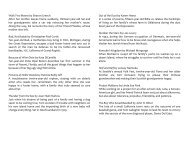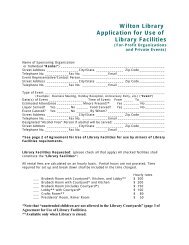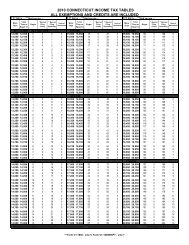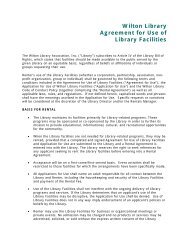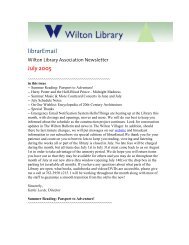CT-1040 Instructions, 2011 Connecticut Resident Income Tax - CT.gov
CT-1040 Instructions, 2011 Connecticut Resident Income Tax - CT.gov
CT-1040 Instructions, 2011 Connecticut Resident Income Tax - CT.gov
You also want an ePaper? Increase the reach of your titles
YUMPU automatically turns print PDFs into web optimized ePapers that Google loves.
Line 56<br />
Multiply the percentage arrived at on Line 54 by the amount<br />
reported on Line 55.<br />
Example: Jen is a <strong>Connecticut</strong> resident who worked in City Y,<br />
a city in State X, during the taxable year. Jen’s filing status is<br />
single and her <strong>Connecticut</strong> adjusted gross income is $160,000.<br />
The amount entered on Jen’s Form <strong>CT</strong>-<strong>1040</strong>, Line 55, is $7,800.<br />
Both State X and City Y impose an income tax. Her <strong>Connecticut</strong><br />
adjusted gross income derived from State X is $80,000 as is her<br />
<strong>Connecticut</strong> adjusted gross income derived from City Y. Because<br />
the amounts of income taxed by both State X and City Y are the<br />
same, Jen uses one column on Form <strong>CT</strong>-<strong>1040</strong>, Schedule 2. Jen<br />
pays an income tax of $6,000 to State X and an income tax of<br />
$360 to City Y. Since Jen’s Form <strong>CT</strong>-<strong>1040</strong>, Line 51, is $160,000,<br />
her Schedule 2 is completed as follows:<br />
Column A<br />
Column B<br />
Line 52 State X, City Y<br />
Line 53 80,000 00 00<br />
Line 54 .5000<br />
Line 55 7,800 00 00<br />
Line 56 3,900 00 00<br />
Line 57 6,360 00 00<br />
Line 58 3,900 00 00<br />
Line 59 Total Credit 3,900 00<br />
Line 57: <strong>Income</strong> <strong>Tax</strong> Paid to a Qualifying<br />
Jurisdiction<br />
Enter the total amount of income tax paid to a qualifying<br />
jurisdiction.<br />
<strong>Income</strong> tax paid means the lesser of your income tax liability<br />
to the qualifying jurisdiction or the income tax paid to that<br />
jurisdiction as reported on a return filed with that jurisdiction,<br />
but not penalty or interest. Do not report the amount of tax<br />
withheld for that jurisdiction directly from your W-2 or 1099<br />
form. You must first complete a return for the qualifying<br />
jurisdiction to determine the amount of income tax paid.<br />
Line 58<br />
Enter the lesser of the amounts reported on Line 56 or<br />
Line 57.<br />
Line 59: Total Credit for <strong>Income</strong> <strong>Tax</strong>es Paid to<br />
Qualifying Jurisdictions<br />
Add the amounts from Line 58A, Line 58B, and Line 58 of<br />
any additional worksheets. The amount on Line 59 cannot<br />
exceed the amount on Line 56. Enter the total here and on<br />
Form <strong>CT</strong>-<strong>1040</strong>, Line 7.<br />
You must attach a copy of your return filed with the<br />
qualifying jurisdiction(s) or the credit will be disallowed.<br />
Schedule 3 – Property <strong>Tax</strong> Credit<br />
<strong>Connecticut</strong> residents must complete Schedule 3 to determine<br />
the amount of credit (if any) that may be taken against a<br />
<strong>Connecticut</strong> income tax liability. The credit is for property<br />
taxes paid during <strong>2011</strong> to a <strong>Connecticut</strong> political subdivision<br />
on a primary residence, privately owned or leased motor<br />
vehicle, or both. You must attach Schedule 3 to Form <strong>CT</strong>-<strong>1040</strong><br />
or your credit will be disallowed. If you entered zero on<br />
Form <strong>CT</strong>-<strong>1040</strong>, Line 10, do not complete this schedule. See<br />
Informational Publication <strong>2011</strong>(20), Q&A: <strong>Income</strong> <strong>Tax</strong><br />
Credit for Property <strong>Tax</strong>es Paid to a <strong>Connecticut</strong> Political<br />
Subdivision.<br />
Which Property <strong>Tax</strong> Bills Qualify<br />
You may take credit against your <strong>2011</strong> <strong>Connecticut</strong> income<br />
tax liability for property tax payments you made on your<br />
primary residence, privately owned or leased motor vehicle,<br />
or both, to a <strong>Connecticut</strong> political subdivision. Generally,<br />
property tax bills due and paid during <strong>2011</strong> qualify for this<br />
credit. This includes any installment payments you made<br />
during <strong>2011</strong> that were due in <strong>2011</strong> and any installments you<br />
prepaid during <strong>2011</strong> due in 2012. Supplemental property tax<br />
bills that were due during <strong>2011</strong> or 2012 also qualify if paid<br />
during <strong>2011</strong>. However, the late payment of any property tax<br />
bills or the payment of any interest, fees, or charges related<br />
to the property tax bill do not qualify for the credit.<br />
<strong>Tax</strong>payers who file a joint <strong>Connecticut</strong> income tax return<br />
may include property tax bills for which each spouse is<br />
individually or jointly liable.<br />
You may take credit for a leased motor vehicle if you had<br />
a written lease agreement for a term of more than one year,<br />
and the property tax became due and was paid during <strong>2011</strong><br />
(either by the leasing company or by you). Refer to your<br />
January 2012 billing statement from the leasing company to<br />
determine the amount of property taxes that may be eligible<br />
for the credit. Your statement will either indicate the amount<br />
of property taxes paid on your leased motor vehicle or<br />
provide you with a toll-free number you may call to obtain<br />
the necessary information. If you do not receive a billing<br />
statement in January 2012, contact your leasing company for<br />
the appropriate property tax information.<br />
Example 1: Lisa received a property tax bill for a motor<br />
vehicle listed on her town’s October 1, 2009, grand list.<br />
The bill was payable in two installments, July 1, 2010, and<br />
January 1, <strong>2011</strong>. If Lisa paid the January 1, <strong>2011</strong>, installment on<br />
January 1, <strong>2011</strong>, she is eligible to claim it on her <strong>2011</strong> income<br />
tax return. If she prepaid it during 2010, she is not eligible to<br />
take credit for it on her <strong>2011</strong> return, but she may have been<br />
eligible to take credit for it on her 2010 return.<br />
Example 2: Mary received a property tax bill for a motor<br />
vehicle listed on her town’s October 1, 2010, grand list.<br />
The bill was payable in two installments, July 1, <strong>2011</strong>, and<br />
January 1, 2012. Mary is eligible to take credit for both<br />
installments on her <strong>2011</strong> income tax return if she paid both<br />
installments during <strong>2011</strong>. If Mary waited until January 1, 2012,<br />
to pay her second installment, she is not eligible to take credit<br />
on her <strong>2011</strong> return for this installment, but she may be eligible<br />
to take credit for it on her 2012 return.<br />
Page 29





